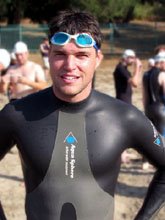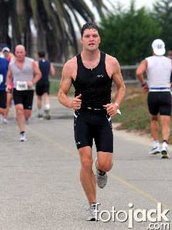Are leg extensions, leg curls, all manner of direct bicep-and-tricep movements, any form of shoulder raises, and calf raises pretty much useless?
There's a fairly assertive and well-credentialed group out there that argues that yes, in fact, that's true: all your weight training needs should be covered by deadlifts, squats, rows, overhead presses, supine presses, and chin-ups, and that further complicating the issue by throwing in dozens of isolation moves is pointless.
The argument--and it's a convincing one--goes something like this: a 200-pound man performing three sets of 10 underhand-grip chin-ups will tax his biceps significantly more than he would doing three sets of 10 curls with 70-pound dumbbells. The chin-up--a compound movement that works the back as well as the biceps-- requires him to move 6000 pounds (3 x 10 x 200), whereas the curl workout would add up to just 4200 pounds (3 x 10 x [2 x 70]). More effort means a more intense workout, which translates into bigger gains in strength and muscle size.
Moreover, the compound-only school argues that the body is "designed" (a term that always chafes me) to move and work as a single unit, so multi-joint moves, which roughly mimic sports-and-real-life athletic movements, are going to make the practitioner a more efficient athlete whose body functions as a whole rather than as a series of disparate pieces.
Like I said, convincing arguments all around, and they've very much shaped my training philosophy over the last few years.
I've had occasion, however, to give this some serious reconsideration of late. After many years away from training for size, I've come back to it in the last few months, partly so I can look and feel the part of a broadsword-wielding Scottish warrior, and partly because I wondered whether, after all these years of performance-based, athletic-enhancing training, I could apply some of the principles I'd learned and return to a hypertrophy-based program both more prudently and effectively than I had in my salad days of max-effort squats in a 20 degree basement at 5:30 AM with no warm-up.
The other reason I was interested in testing the size-building capacity of my now 36-year-old body is that I occasionally--very occasionally--get male clients who say "money and training frequency is no object. I just want to get as big as I can as fast as I can and I'm willing to do whatever it takes."
I do train in Los Angeles, after all, the land of fairies, leprechauns, and the occasional guy with a major studio behind him willing to foot the bill for whatever it takes to get him to look good shirtless. These people do exist. Curse them.
So it's in my interest to have at my disposal training techniques that will do the job.
And here's what I've come up with, circling back around to the question of single-joint exercises. In my opinion, if you want a Men's Health/Women's Health model LOOK, that is, if you want to look both maximally defined AND muscular, you've got to include some single-joint moves.
I am NOT talking about maximal performance here. I'm not talking about getting faster or more resiliant on the playing field. I'm not even talking about health per se, certain aspects of which may actually be compromised by single-joint work. I'm talking about straight-up, good-old fashioned, flex-in-the-mirror, get-stares-of-approbation-at-the-beach VANITY. In my opinion, to achieve that LOOK, you've gotta throw in some moves exclusively for vanity's sake, to wit, some single-joint moves.
Some words of qualification: I don't think single-joint moves are of much use to someone who only has three hours a week to train. It's certainly possible to make some excellent gains on such a program, and for the vast majority of the population, with stressful jobs, families, limited sleep, and sometimes erratic eating habits, such a program may very well be near-optimal. There's enough recovery time built in to ensure good gains, and on a well-designed, three-day-a-week, full-body program, the sky can pretty much be the limit. So I still put most clients who have three, or even just two days a week to train, on a program consisting almost entirely of the tried-and-true compound movements.
But again, if I were talking about a program for maximal size, I'd put the client on a split system, up the training frequency, up the volume, and increase the protein and caloric intake significantly. Compound moves would still form the backbone of the program, but I'd definitely include up to 40% isolation moves as well, including moves for the biceps, triceps, and calves.
This sounds very much like a Weider-style bodybuilding program, and indeed that's pretty much what it is: if you're talking sheer size--or, in the case of women, sheer lean, defined muscularity, there's got to be some isolation thrown in to support and enhance the effectiveness of the compound moves. Aesthetically, and I repeat that I am talking ONLY aesthetically, isolation moves create a more complete physique.
I feel funny saying all this, in a way, because most casual exercisers go into the gym and do ONLY single-joint moves, and that's the huge mistake that most of the multi-joint advocates are trying to warn against. Such exercisers don't squat or dead-lift at all, they use only machines, they use tiny weights on isolation moves that they shouldn't TOUCH unless they're in the gym five days a week and have already done all the pressing, rowing, lunging and/or squatting they can manage for the day. Such people are lost souls with little hope of improving in the near future, and they need to be schooled on the undeniable benefits of the basics and banned from using anything with a cam or a pulley or a Velcro strap until they’ve built themselves a good foundation.
As a final note, I would also say that I would NEVER put a client on an intense bodybuilding-based program for more than a few weeks at a stretch without cycling in periods of less intense, less concentrated workouts. As I suggest above, training only for looks, and doing lots of single-joint work on top of your basics, can actually be a recipe for injury. Bicep curling, for instance, can be very tough on your front shoulders; leg curling can make your hamstrings more injury-prone. Do such a program long enough, and things will start to pop and crack in unpleasant ways.
So, to sum up: for the casual trainee looking to look and feel good, or for people looking to improve sports performance or just to feel strong and healthy doing everyday activities, a three-day-a-week weight training program consisting pretty much exclusively of compound moves is most assuredly the way to go. Don't even think about spending a lot of time curling, tricep-extending, or calf-raising, much less pec-decking or cable-crossovering. But if you're looking for the extra 20% edge in your appearance, you're putting in the time on the compound moves already, and you've got the time, dedication, and energy outside the gym to support your efforts with optimal diet and rest, in this trainer’s opinion, single-joint moves are indispensable.
Incredulous protests, rude comments, and anecdotes from personal experience are very much welcome.
Thursday, September 20, 2007
Are Single-Joint Moves a Waste of Time?
Subscribe to:
Post Comments (Atom)




No comments:
Post a Comment